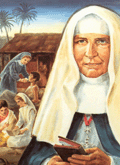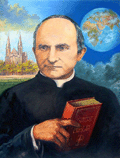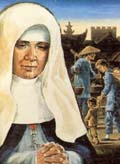
Josepha
Hendrina,
Co-Foundress
On December 8, 1889, in the little village of Steyl in the Netherlands, Arnold Janssen founded the women’s Mission Congregation, Servants of the Holy Spirit. He had already opened the first men’s German mission house there in 1875 and founded the Society of the Divine Word (SVD). The women who came to Steyl, hoping to become missionary sisters and dedicate their lives to the work of spreading the faith, went through a long and arduous time of waiting. Seven years of perseverance in difficult living and working conditions tested and clarified their vocation before they finally began their religious life. In 1893 the Bishop of Roermond approved their constitutions. On March 12, 1894 the first twelve sisters took their vows.
Soon after the foundation, intensive preparation for mission overseas began in earnest, mainly with language studies, establishment of a teachers’ training course, and instruction in a variety of practical matters. The co-foundresses, Sr. Maria (Helena Stollenwerk) and Sr. Josepha (Hendrina Stenmanns) were entrusted with the main leadership responsibilities, introducing new members to religious life and organizing the practical work. They also developed the young congregation spiritually, filling it with their enthusiasm for the mission apostolate and a spirit of unconditional commitment.
The congregation grew rapidly. The convent opened its doors to women for retreats. The large numbers of retreatants absorbed the spirit of the community and many young women applied to join as missionary sisters. In 1895 the first sisters were sent to Argentina; in 1897 a group went to Togo.From then on the second co-foundress of the Missionary Sisters, Sr. Josepha, took on the leadership. Under her, more sisters were sent out: in 1899 to New Guinea, in 1901 to the United States and in 1902 to Brazil
After the premature death of Sr. Josepha (1903), Arnold Janssen appointed Sr. Theresia Messner as first superior general. The First General Chapter (1910) confirmed her in that office for a further twelve years. During that time the Congregation developed significantly. Sr. Theresia initiated the legal separation from the SVD and with that, its independence as an international congregation. During that time, the Adoration Sisters also became an autonomous congregation with their own constitutions
The number of members grew rapidly and the congregation was able to found new missions in China, Japan, Germany, Austria, the Philippines, Mozambique, Indonesia, Paraguay and Poland. By 1946 further foundations were made in countries such as Chile, England, India, Slovakia, Switzerland, Australia and Ghana. In the 1950s openings in Spain, Taiwan and Paraguay took place. Women from different countries entered and the congregation became more international.
After the Second Vatican Council, the congregation initiated a period of profound renewal. The spiritual wellsprings of the founding generation were to be given suitable expression for today’s world, life was to be more closely oriented to the gospel and the mission charism was interpreted in light of today’s understanding. General chapters worked out new constitutions, founding the religious-missionary life of the congregation firmly in the sharing of life and mission with the Lord. The Trinitarian spirituality was seen more and more as the wellspring of our mission apostolate.
After 1980, new foundations grew up in Angola, Botswana, Bolivia, Mexico, Korea, Portugal, Ukraine, Russia, Romania, Ethiopia and Cuba, Zambia, Antigua, South Africa, Benin, St. Kitts, Moldova. There was a shift from institutions and large communities to life for and with the poor and underprivileged, small communities in the midst of the people, on the outskirts of cities or in remote areas of specific countries. The priorities today are woman and people living with HIV/AIDS, as well as marginalized people in general. The numerous different nationalities and languages give the congregation a decidedly international flavor.Today the congregation is rekindling the original fire of missionary enthusiasm, oriented to today’s and future mission challenges in a torn and increasingly secular society. We try to respond to these challenges through our prophetic presence as women, seeking to bring about life-giving relationships


